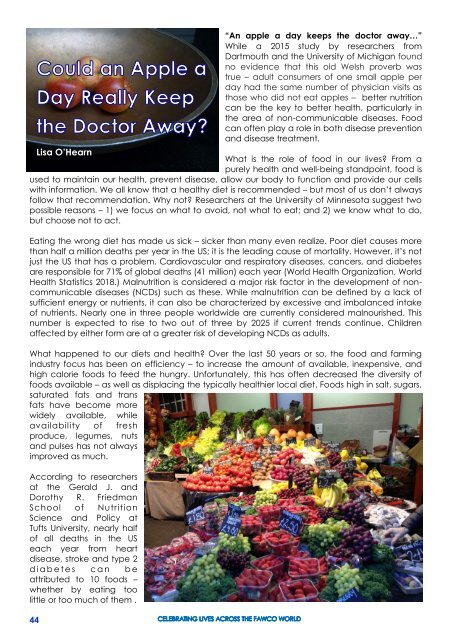Inspiring Women SUMMER 2020
Create successful ePaper yourself
Turn your PDF publications into a flip-book with our unique Google optimized e-Paper software.
44<br />
“An apple a day keeps the doctor away…”<br />
While a 2015 study by researchers from<br />
Dartmouth and the University of Michigan found<br />
no evidence that this old Welsh proverb was<br />
true – adult consumers of one small apple per<br />
day had the same number of physician visits as<br />
those who did not eat apples – better nutrition<br />
can be the key to better health, particularly in<br />
the area of non-communicable diseases. Food<br />
can often play a role in both disease prevention<br />
and disease treatment.<br />
Lisa O’Hearn<br />
What is the role of food in our lives? From a<br />
purely health and well-being standpoint, food is<br />
used to maintain our health, prevent disease, allow our body to function and provide our cells<br />
with information. We all know that a healthy diet is recommended – but most of us don’t always<br />
follow that recommendation. Why not? Researchers at the University of Minnesota suggest two<br />
possible reasons – 1) we focus on what to avoid, not what to eat; and 2) we know what to do,<br />
but choose not to act.<br />
Eating the wrong diet has made us sick – sicker than many even realize. Poor diet causes more<br />
than half a million deaths per year in the US; it is the leading cause of mortality. However, it’s not<br />
just the US that has a problem. Cardiovascular and respiratory diseases, cancers, and diabetes<br />
are responsible for 71% of global deaths (41 million) each year (World Health Organization, World<br />
Health Statistics 2018.) Malnutrition is considered a major risk factor in the development of noncommunicable<br />
diseases (NCDs) such as these. While malnutrition can be defined by a lack of<br />
sufficient energy or nutrients, it can also be characterized by excessive and imbalanced intake<br />
of nutrients. Nearly one in three people worldwide are currently considered malnourished. This<br />
number is expected to rise to two out of three by 2025 if current trends continue. Children<br />
affected by either form are at a greater risk of developing NCDs as adults.<br />
What happened to our diets and health? Over the last 50 years or so, the food and farming<br />
industry focus has been on efficiency – to increase the amount of available, inexpensive, and<br />
high calorie foods to feed the hungry. Unfortunately, this has often decreased the diversity of<br />
foods available – as well as displacing the typically healthier local diet. Foods high in salt, sugars,<br />
saturated fats and trans<br />
fats have become more<br />
widely available, while<br />
availability of fresh<br />
produce, legumes, nuts<br />
and pulses has not always<br />
improved as much.<br />
According to researchers<br />
at the Gerald J. and<br />
Dorothy R. Friedman<br />
School of Nutrition<br />
Science and Policy at<br />
Tufts University, nearly half<br />
of all deaths in the US<br />
each year from heart<br />
disease, stroke and type 2<br />
d i a b e t e s c a n b e<br />
attributed to 10 foods –<br />
whether by eating too<br />
little or too much of them .

















